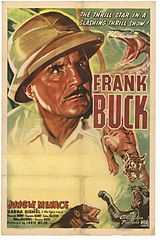Louis Weiss (producer)
| Adolph, Louis, and Max Weiss | |
|---|---|
| Born |
December 21, 1890 New York |
| Died |
December 14, 1963 Los Angeles |
| Occupation | film and television producer |
| Years active | 1920–1958 |
| Spouse(s) | Ethel Weiss |
| Children | Adrian (b 1919), Peggy (b 1921) |
Louis Weiss (December 21, 1890 – December 14, 1963, Los Angeles) together with the Weiss Brothers' was a low budget independent producer of film serials such as Frank Buck's Jungle Menace (1937).
Early life
Louis Weiss was born in New York, and left school after third grade (elementary school), according to the 1940 US Census.
Early films
The brothers Adolph, Louis, and Max Weiss entered film production in the early 1920s with money earned from a New York lamp-and-fixture store, phonograph sales, and ownership of a theater that developed into a small chain. Operating under such monikers as Superior Talking Films, Stage and Screen Productions, Artcraft Productions, Exploitation Pictures, Consolidated Pictures, and International Pictures Corporation, the brothers produced a variety of low-budget films.
Most were never reviewed or copyrighted, apparently deliberately avoiding press attention. The only record of their existence is found in an occasional release chart, a few advertisements, and surviving prints. Though most Poverty Row producers averaged a six-reel length, or about sixty minutes, Weiss continually tried to pare that down to five reels, lasting just over fifty minutes.[1]
A successful early Weiss film was The Revenge of Tarzan (1920). By the time Louis Weiss came to produce Jungle Menace for Columbia Pictures, he had had considerable experience making silent jungle films, as well as Westerns with plenty of action.
Jungle Menace

Unlike Universal Studios, in the early 1930s Columbia could not offer exhibitors a complete package including serials and newsreels. However, with the disappearance of such independent serial producers as Mascot Pictures Corporation and smaller companies, Columbia decided in 1937 to enter the serial field with Jungle Menace, competing primarily with Universal and Republic Pictures. Columbia was already a mainstay of the Saturday-afternoon audience through its westerns, and the steady profitability of these films may have convinced studio boss Harry Cohn to expand Columbia's participation in this market to include serials.
To produce Jungle Menace, Columbia contracted with Louis Weiss and hired Frank Buck for his first dramatic starring role. Jungle Menace was very successful, attracting more than the typical number of juvenile audiences for its 15 weekly chapters. Exhibitors were immediately convinced that Columbia was a viable entry into the serial field, where it would remain active through the mid-'50s and the death of the form.[2]
Louis Weiss went on to produce more successful serials, both for theaters and television. He was the father of producer Adrian Weiss, who worked with him on Jungle Menace.
References
- ↑ Tino Balio. Grand Design: Hollywood as a Modern Business Enterprise, 1930–1939 (History of the American Cinema, No. 5), University of California Press (January 29, 1996) p. 327
- ↑ Brian Taves. Studio Metamorphosis. Columbia's Emergence from Poverty Row. In Frank Capra. (Culture and the Moving Image by Robert Sklar. Temple University Press) (March 30, 1998) p 248
Bibliography
- Lehrer, Steven (2006). Bring 'Em Back Alive: The Best of Frank Buck. Texas Tech University press. p. 248. ISBN 0-89672-582-0.
External links
- Louis Weiss on the Internet Movie Database
- Weiss Bros. – Artclass and Beyond – The Sound Era http://kitparkerfilms.wordpress.com/2012/11/17/weiss-bros-artclass-and-beyond-the-sound-era/
|